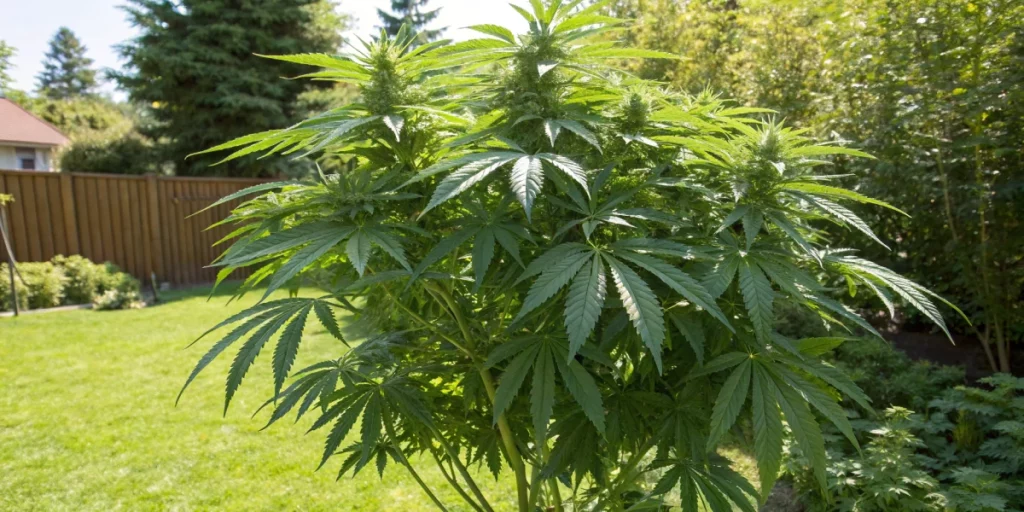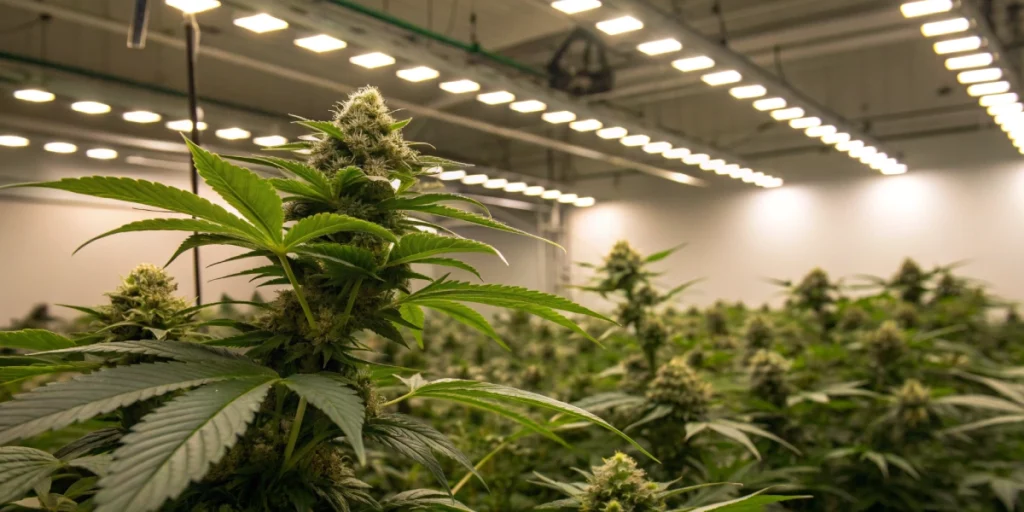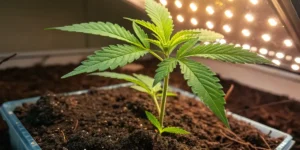Sweet Skunk Auto Strain: Exceptional Genetics and Effects
Origins and Genetics
Sweet Skunk Auto Strain comes from a cross between Early Skunk and a Ruderalis variety, giving it the auto-flowering trait. The result is a balanced hybrid that retains the classic skunky aroma while adding sweet, fruity undertones. It inherits its strong structure from the Skunk lineage, while the Ruderalis genetics ensure a short and predictable life cycle.
This strain is designed for those who want consistent results in a compact timeframe. The auto-flowering nature removes the need for changing light schedules, making it perfect for beginners or anyone looking for a low-maintenance plant that still delivers solid yields.
Effects and Potency
Sweet Skunk Auto Strain offers a mellow, relaxing effect that doesn’t overwhelm. It’s known for producing a mild head buzz followed by gentle body calm. The balance makes it ideal for social use or winding down after a busy day without feeling too sedated.
Its flavor is as enjoyable as its effect. Expect a mix of sugary sweetness with a hint of musk and spice. With THC levels typically between 14% and 19%, it offers just enough punch without pushing into intense territory. It’s well-suited for those who enjoy flavor and balance over raw strength.

Environmental Requirements for Growing Sweet Skunk Auto Strain
Setting Up the Growing Cannabis Space
Creating a good space for Sweet Skunk Auto Strain starts with airflow and light. This strain prefers a clean area with steady air circulation. You don’t need an elaborate setup, just a grow tent, small fan, and reliable light source. A carbon filter helps manage its strong skunky scent during flowering.
Use pots with proper drainage and a light, airy growing medium like coco coir or well-aerated soil. This allows the roots to breathe and prevents overwatering. Add a thermometer and hygrometer to your setup so you can keep things dialed in from week to week. Poor environmental control is one of the common reasons for cannabis seeds not germinating, so maintaining optimal conditions is key from the very start.
Temperature and Humidity
It thrives in a temperature range of 20–26°C during the day and a few degrees cooler at night. Keep humidity at 60% in early growth and drop it to around 40% in flowering to avoid mold or mildew on the dense buds.
Indoor Cannabis Cultivation
Advantages of Growing Indoors
Indoor growers love Sweet Skunk Auto Strain because it’s compact and finishes fast. In a small space, it can produce dense, sticky buds in just 9 to 10 weeks from seed. With indoor growing, you control light, humidity, and temperature, giving you consistent quality every time.
You can fit several plants into one tent thanks to its small stature. This makes it a favorite for urban growers or anyone short on space. Even with minimal equipment, you’ll be impressed by how resilient and productive this strain can be indoors.
Lighting Needs
Use full-spectrum LED lights or compact fluorescents. Give the plant 18–20 hours of light per day from seed to harvest. Keep lights close enough for intensity but far enough to avoid heat stress. Even modest setups deliver great results if the light is steady and well-positioned.
Outdoor Cannabis Cultivation
Best Conditions for Outdoor Growth
Sweet Skunk Auto Strain grows best outdoors in warm, sunny weather. It prefers long days and lots of direct sunlight but can also finish before the first frost in cooler climates. Since it flowers automatically, you can plant it multiple times in one season.
This strain stays small, making it easy to hide in gardens or on balconies. Use large pots or plant directly in rich soil. Keep an eye out for pests and water consistently, especially during dry spells. With just a little care, outdoor plants can produce surprisingly dense buds.
Advantages of Growing Sweet Skunk Auto Strain
Sweet Skunk Auto Strain is one of the easiest autos to grow, even for beginners. It doesn’t require topping or trimming, and it grows quickly with minimal feeding. You can go from seed to harvest in under 10 weeks, with little risk of common problems.
Its balanced effects, rich aroma, and dense bud structure make it attractive to both home growers and micro-producers. Whether grown indoors or out, this strain gives back what you put in—and then some. It’s fast, low-maintenance, and rewarding.
Problems in Cultivating Sweet Skunk Auto Strain
Overwatering
This strain is prone to root issues if overwatered. Let the top inch of soil dry before watering again. Always use pots with good drainage and avoid heavy soils that hold excess moisture.
Pest Infestations
Outdoors, Sweet Skunk Auto Strain can attract aphids, whiteflies, or caterpillars. Use neem oil or insecticidal soap early on as a preventative. Inspect leaves regularly and act quickly at the first sign of damage.
Similar Strains
Skunk #1 Auto
A close relative with the same signature skunky aroma, Skunk #1 Auto shares the easy-growing and compact structure of Sweet Skunk Auto Strain. Great for growers who want classic flavor in a modern auto package.
Cheese Auto
Cheese Auto offers a pungent aroma and relaxing high, similar to Sweet Skunk Auto Strain but with more emphasis on creamy, cheesy notes. It’s another beginner-friendly strain with strong yield potential.
Critical Auto
Critical Auto is favored for its short flowering time and strong, earthy aroma. Like Sweet Skunk Auto Strain, it delivers a smooth, mellow high and requires little maintenance, making it perfect for fast harvests.
Week-by-Week Growth Plan for Sweet Skunk Auto Strain
Week 1 – Germination and Seedling Stage
Start seeds in a paper towel or directly in starter plugs. Once the taproot emerges, place the seed into a small pot under gentle light. Keep humidity high and soil moist, but not wet.
Week 2 – Early Seedling Growth
Leaves begin forming as roots establish. Use mild lighting and monitor humidity around 60%. Begin light air circulation to strengthen stems. Avoid overfeeding or watering.
Week 3 – Vegetative Growth Begins
Growth speeds up. The plant expands its leaves and builds strength. Increase light intensity and begin light feeding with nitrogen-rich nutrients. Train gently if needed.
Week 4 – Full Vegetative Growth
Stems thicken and leaves multiply. Maintain regular feeding and water when topsoil dries. Consider low-stress training to open the canopy for even light coverage.
Week 5 – Transition to Flowering
Pre-flowers appear, and the plant may stretch in height. Reduce nitrogen slightly and increase phosphorus and potassium. Watch for pistils at the nodes.
Week 6 – Early Flowering
Buds begin forming, and aroma increases. Adjust light distance and airflow to support flower growth. Continue bloom feeding schedule and monitor humidity.
Week 7 – Bud Development
Buds swell and trichomes begin forming. Lower humidity to around 45%. Feed with full bloom nutrients and ensure even light coverage across the canopy.
Week 8 – Ripening Phase
Buds become denser and more aromatic. Trichomes turn cloudy. Reduce feeding slightly and monitor for signs of ripeness. Flush if using synthetic nutrients.
Week 9 – Final Maturation
Check trichomes for signs of amber. Pistils darken. Reduce watering and prepare to harvest once most trichomes are cloudy with some amber.
Week 10 – Harvest Time
Cut plants and hang branches in a dark, ventilated area. Dry slowly for 7–10 days. After drying, cure in jars for at least two weeks to enhance flavor and potency.

FAQs about Sweet Skunk Auto Strain
How long does Sweet Skunk Auto Strain take from seed to harvest?
Sweet Skunk Auto Strain typically completes its full life cycle in 9 to 10 weeks from seed. This includes germination, vegetative growth, flowering, and ripening. Its fast turnaround makes it ideal for growers seeking quick results with minimal effort.
What does Sweet Skunk Auto Strain taste like?
This strain combines classic skunky flavor with sweet, earthy undertones. Users describe the taste as a mix of sugary herbs and musk, with a lingering spicy finish. The aroma is strong and easily fills a room, especially in late flowering.
Can Sweet Skunk Auto Strain grow in colder climates?
Yes, it can be grown in colder regions if started during warmer months. Its auto-flowering genetics allow it to finish before the first frost. Outdoor growers in northern zones often plant it in early summer for best results.





